
It has been long due, but a bustard hatchery centre has finally come up in Jaisalmer, Rajasthan. And now, the scientists, including a team of experts from Abu Dhabi, are desperately searching for bustard eggs to pull back the world’s most threatened bird from extinction.
The Great Indian Bustard was listed as a Critically Endangered bird in 2011 by Birdlife International and IUCN (International Union for Conservation of Nature). In 2012, India announced a multi-crore plan to save the bird – Project Bustard, and in 2013 the idea of a captive breeding centre was first formulated. Now, 6 years and innumerable ‘action’ plans later, the Rajasthan government finally has a state level idea that is being executed.
Also Read: Gujarat Fears It has Lost its Only Great Indian Bustard
In recent months the bustard population has collapsed to a number anywhere between 135 and 160. This is almost 87% loss in numbers since 1969 when there were reportedly more than 1200 of these grassland birds found in a much larger territory in the Indian subcontinent. Now, handfuls remain, scraping for their life in Rajasthan, Gujarat, Madhya Pradesh, Andhra Pradesh, Maharashtra and Karnataka.
It is only Rajasthan where more than a 100 exist today and where the regal looking birds have a chance to be protected and saved from extinction.
India’s Endangered has been keeping a watchful eye on the birds and the plans of state and central government to save them over the years. You can read the timeline here.
The Egg Hunt in Rajasthan
In June this year, on World Environment Day, the Rajasthan state government chartered out its own recovery plan and announced a Rs.12 Crore Project Great Indian Bustard.
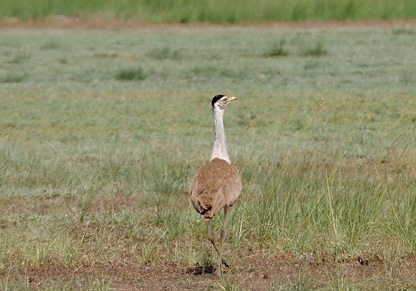
“We plan to spend about Rs 4.5 crore this year on constituting enclosures and securing inviolate areas to ensure successful breeding of birds in the Desert National Park. A good number of birds are also found outside protected areas in Ajmer and Jaisalmer districts. In the coming years, we will spend close to Rs 8 crore at the breeding sites of bustards outside the protected areas,” says P S Somashekhar, chief conservator of forests (wildlife), Rajasthan.
As the first phase of the project, the world’s first GIB breeding centre has been set up in Sorsan in the state and the first hatchery at Ramdeora in Jaisalmer to artificially incubate the bird’s eggs. But for the project to take off the eggs need to be collected from the wild first, and that’s where the experts from Abu Dhabi come into the picture.
Also Read: The Perils of Being a Great Indian Bustard
The Houbara Bustard, a bird like GIB was having a tough time a few years back surviving in the Middle East. It is found across northeast Asia, central Asia, the Middle East and the Arabian Peninsula. Its recovery was credited largely to the artificial breeding done at the breeding centre in Abu Dhabi conducted by the International Fund for Houbara Conservation.
Now, the state government hopes that same expertise can be used to save the Indian bustards and has invited Dr. Sadrik and his team from Abu Dhabi. For now the government has approved of collecting 25 eggs in 3 years but the forest department is keen on completing this work in 2 years.
Senior WII scientist Dr Y.V. Jhala, who is overseeing Project Bustard in Jaisalmer, is quite optimistic about its success.
“For many years, Project Bustard just did not take off, for a number of reasons,” he said. “But now it’s on the right track. Things have changed miraculously in the past few weeks. We are hoping for a breakthrough soon.”
On June 20th the experts collected 2 wild bustard eggs giving a start to the project. As per the latest reports, 6 total eggs have been collected and taken to the hatchery centre.
“A beginning has been made and I hope we are able to save the bird,” Arindam Tomar, the state’s chief wildlife warden, told Mongabay.
The Wildlife Institute of India, Rajasthan Forest Department and India’s environment ministry have entered into an agreement to build two captive breeding facilities for the great Indian bustards (Ardeotis nigriceps). The main, bigger facility is being constructed in the village of Sorsan in southeast Rajasthan, while a second, smaller facility is being built in Jaisalmer, in the west, close to where many of the wild birds breed.
The buildings will take a year or two to come up, Tomar said, but the hunt for eggs is on because the teams “did not want to miss this year’s breeding season.”
“That was the urgency of doing it,” he said. “There are only 150 great Indian bustards surviving in the wild, so every day is precious. We don’t have any captive population of great Indian bustards at all, we don’t have them in any zoos or anywhere else.”
The question however is, will captive breeding of a bird that has difficulty breeding even in natural environment, really be able to reverse the population crisis of the Indian bustard? Expert opinions are divided.
Will Captive Breeding Help?
It is a known fact that bustards are a difficult bird to breed in captivity. And India right now does not have someone who has expertise on the subject.
Bustards require privacy and security, and cannot be housed with other species. They are prone to a variety of diseases and contract myopathy – stress caused by muscle exertion. Bustard management is far from easy, and a well-researched methodology is paramount before we can even begin to think about establishing such a programme, writes Arjun Awasthi for Sanctuary Asia.
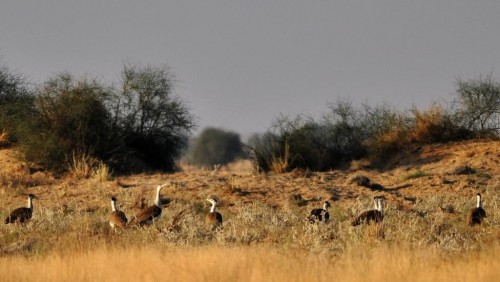
Tomar, Chief Wildlife warden of Rajasthan is fearful too of the success though he believes the step is a must to at least give a fighting chance to the birds.
“It’s going to be very difficult first to incubate the eggs, then to rear the chicks,” Tomar said to Mongabay. “Then there’s the next challenge of whether the birds are able to breed or not. If they start breeding, then we might have a population that we can start releasing in the wild again. The effort now is to create a founder population of breeding birds, chicks of which can probably be rewilded. So it’s going to be a very long process.”
There is also an opposing notion that captive breeding is not the right approach.
A study by Dolman and team in 2015 said that the species’s population dynamics of the GIB suggested that establishing effective in situ (in their natural habitat) conservation measures within the next 10 years and not removing eggs from the wild would recruit more adult females to the wild population within 30 years than a programme of captive breeding and releases.
Also Read: In a First Scientist Track Great Indian Bustard Flight
The research additionally showed that egg collection and rearing could establish a captive population only in the most favourable conditions. Such a programme would also require a large number of wild eggs to be removed, around ten a year for eight years according to the study, putting the wild population under greater stress. This is 4 more than the approved 6 by the Indian government.
This means anyone undertaking a captive breeding programme would need to assess the considerable expertise, materials, labour and money it would require to sustain an ‘above average’ performance for over half a century – no mean feat in an already under-funded sector.
The most pressing problems in bustard habitats are,
- Power Transmission Lines and Windmills (Causing at least 6 premature deaths in the past couple of years)
- Feral Dogs hunting chicks, and stealing eggs
- Hunting
So even after the captive breeding is a success, effective habitat restoration has to be done at the same time to ensure released birds have sufficient and a safe habitat to return to.
It is a beginning, but the perils are far from over for the Great Indian Bustard.
If you liked what you read and wish that we continue to bring stories of lesser known species into the mainstream, do support our work by clicking here.

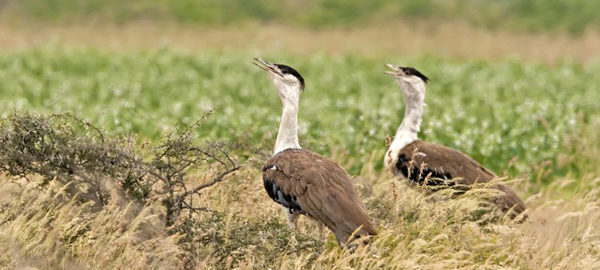
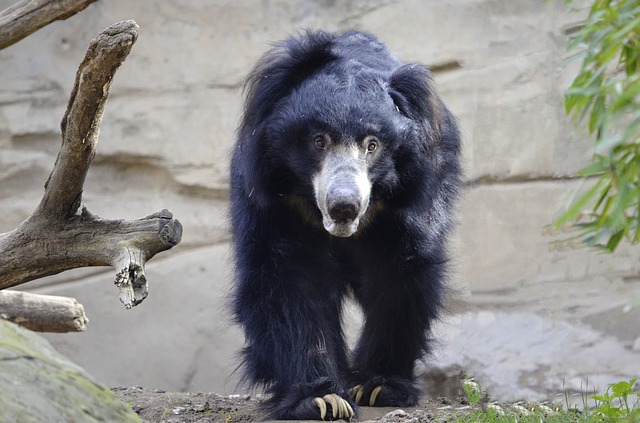
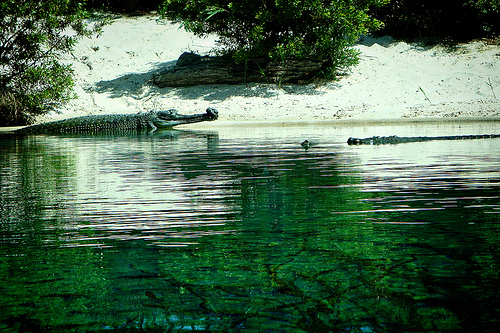


One thought on “Wanted – Eggs of the Great Indian Bustard”